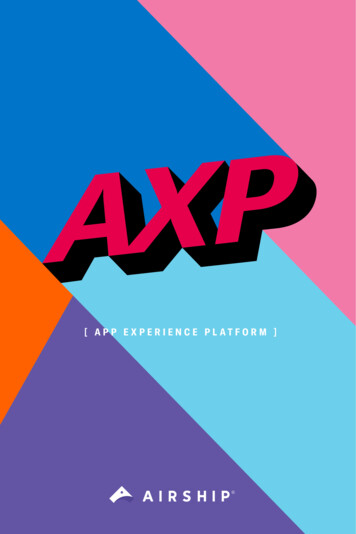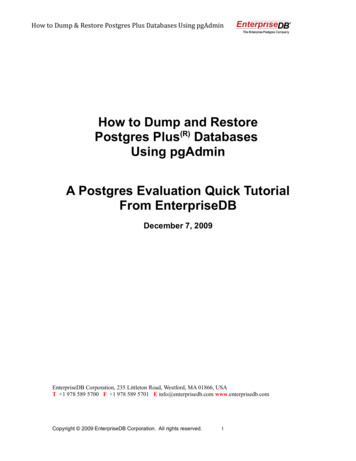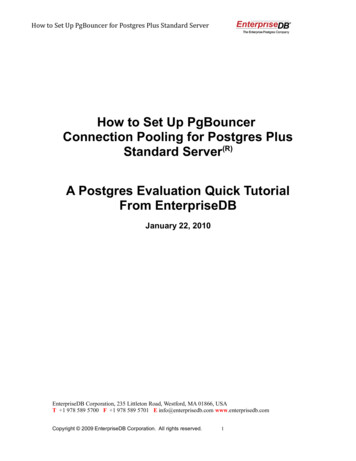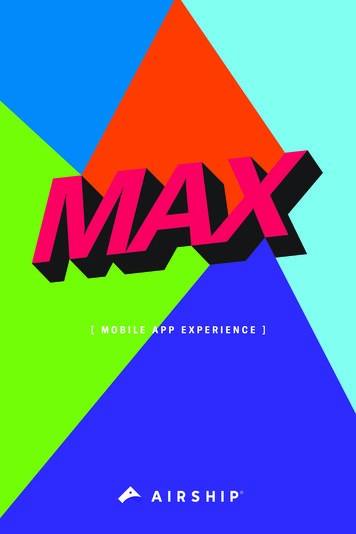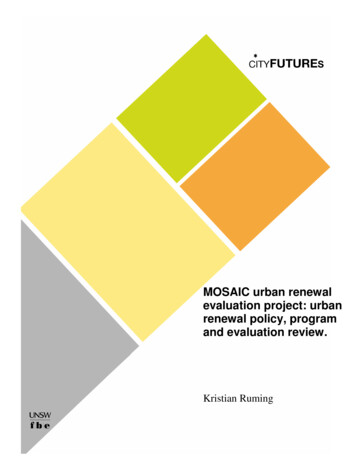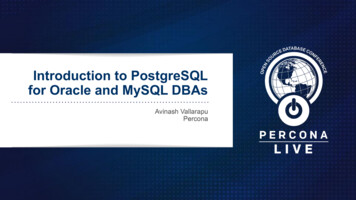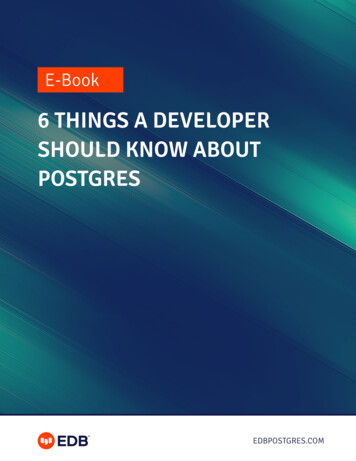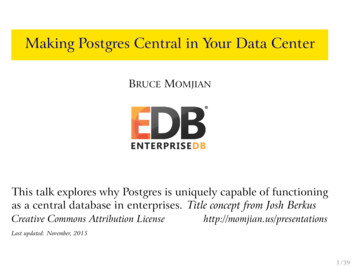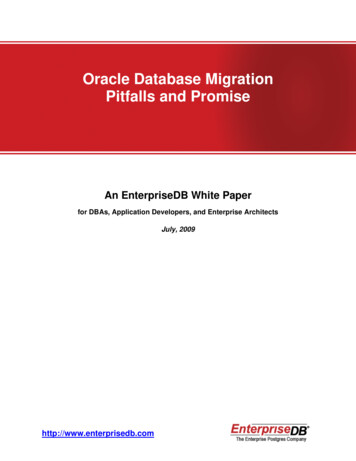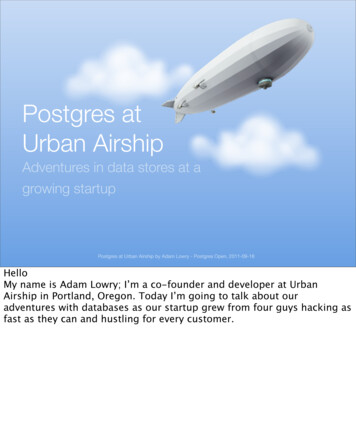
Transcription
Postgres atUrban AirshipAdventures in data stores at agrowing startupPostgres at Urban Airship by Adam Lowry - Postgres Open, 2011-09-16HelloMy name is Adam Lowry; I’m a co-founder and developer at UrbanAirship in Portland, Oregon. Today I’m going to talk about ouradventures with databases as our startup grew from four guys hacking asfast as they can and hustling for every customer.
A Growing StartupWe power the world’s most successful mobile apps.The Urban Airship platform is the engagement and monetization engine behindthousands of the world’s most successful mobile apps.Postgres at Urban Airship by Adam Lowry - Postgres Open, 2011-09-16Urban Airship is a mobile services platform, providing tools forengagement and monetization for mobile application developers.We have web services and libraries to do push notifications -- shortmessages delivered over the data network on behalf of an application -and content-delivery for in-app purchases.
How did it all start? May 2009: Steven Osborn, Michael Richardson, ScottKveton, and myself start Urban Airship June 2009: iOS 3.0 released; our system powered pushnotifications for the first app in the store using push: TapTap Revenge 2 “Can we do this in 3 days?” “Yes.” “We have N millionactive users.” “Y- um. Yes.”Postgres at Urban Airship by Adam Lowry - Postgres Open, 2011-09-16The four of us started in May of 2009Steven and Scott had left our previous employer, but Michael and I waitedit outSteven had been doing some part time server work with an indie iOSgame studio. When the iOS 3.0 developer betas were released he lookedat the In-App Purchase guide and said, I don’t want to do this -- wait,other people won’t want to do this either.- First real customer, Tapulous. “Can we do this in 3 days?” “Yes.” “Wehave X million active users.” “Y- um. Yes.”
Staying ahead of the avalanche August 2009: Sent over one million production notifications August 2011: Sent over five billion production notifications Tracking over 300 million installationsPostgres at Urban Airship by Adam Lowry - Postgres Open, 2011-09-16We were clearly in the right place at the right time.A little while ago wepassed the 5 billion marker, which was pretty exciting for us. We’ve alsoreleased several products -- rich push, which I’ll mention later,subscriptions, and we expanded our push service to Android andBlackBerry5 billion is a great, round number, but sending notifications alonedoesn’t require much in the way of data storage -- what matters is thenumber of installations. Each of those 300 million installations is apotential recipient, and we need to have metadata on that recipientindexed and ready to decide whether a particular API call results in amessage to them.To clarify, this doesn’t mean 300 million devices, but installations of anapp using us on a device.The result is a large working set with few hot points, and pretty writeheavy
Postgres at Urban Airship by Adam Lowry - Postgres Open, 2011-09-16My goal today is to talk about our path, and hopefully someone can learna little from our mistakes, or at least have a little bit of an laugh.
Original Architecture All EC2 Python / Django application servers Single PostgreSQL 8.3 instance pg dump backups sent to S3, and WAL shipping for warmstandbyPostgres at Urban Airship by Adam Lowry - Postgres Open, 2011-09-16We started out with the simplest thing we could build to provide theservice. A single layer of Apache/mod wsgi python servers, with a singleDB server.To start, no ops team. Later, no DBAs; only a dev ops working togetherFor reliability we did the standard warm standby with log shipping. It wasmy third time setting this up, and it was a pain every time. I never gotcomfortable with my scripts, but the shipping itself did save us onmultiple EC2-caused instances.
Device tokens 32 Bytes Same for multiple apps on the same device, but differentmetadata Application ID, token, active?, created, alias, CD110B364A0658BEBFPostgres at Urban Airship by Adam Lowry - Postgres Open, 2011-09-16To provide a frame of reference for what we were working with, here’s adevice token.A device token is the unique identifier for Apple’s push notificationsystem. It’s 32 Bytes, and on an installation of iOS it’s the same fordifferent apps.For us we stored in a row with the application ID, whether it’s active ornot (that is, can we send to it without violating Apple’s rules?), andvarious other bits of metadata like alias, created timestamp, and a manyto-many relationship for any tags applied to the DT by the application.
A little naive Data model: surrogate keys led to extra joins, inefficientindexes EC2 woes: very hard to get decent performance in EC2;especially with EBS volumes Registration API: Even device tokens that would neverreceive a push caused regular writes Preparing for Rich PushPostgres at Urban Airship by Adam Lowry - Postgres Open, 2011-09-16Our initial setup was working, but it was starting to creak.Data modelEC2/EBS- ec2 I/O throughput was just terrible, and EBS was worse. We ended upwith 4 EBS volumes RAIDed, and still we were barely keeping up.Come back to EC2 issues laterWhen we were designing our Rich Push system the scaling troubles forour Push system had me nervous.-- describe rich push -How was I going to take the same level of service, but store every singlemessage? A single API call could result in 10 million writes!
Enter Mongo Preparing for Rich Push —I was totally scared. See Michael Schurter’s talk,Scaling with MongoDBhttp://bit.ly/schmongodbPostgres at Urban Airship by Adam Lowry - Postgres Open, 2011-09-16In late 2009/early 2010 we started work on a new product, now calledRich Push. The idea was to complement push notifications, which arefire-and-forget and can be lost if the user doesn’t see them beforeanother comes, with a persistent inbox for every user of an app.The amount of writes necessary frightened me; a single API call couldresult in 5 million writes.At the same time we wanted to add more write-heavy features to theprimary push notification system, but I didn’t think our currentPostgreSQL installation was going to handle it at our growth rate. So wewent looking for alternatives.
Mongo: the Good Crazy-easy setup and administration, including replication Flexible querying Fast in-place updates* Auto-sharding coming for future expansionPostgres at Urban Airship by Adam Lowry - Postgres Open, 2011-09-16Mongo is a document based store. You have a collection, which is like atable, and a document, which is like a row. The storage format is BSON,which is a binary format similar in structure to JSON, but with more datatypes. It uses memory-mapped filesSetup for both developers and ops is easy, asynchronous replicationsetup very easyFlexible queryingFast in place updates with an asteriskWe were working on mongo 1.2 1.4 primarily; auto-sharding came in1.6 but never worked reliably for us. Mongo 2.0 just released recently.
Mongo: the Bad No durability (until journal added in 1.8) No guarantee data was written at all unless safe True Databases and collections are created on demandPostgres at Urban Airship by Adam Lowry - Postgres Open, 2011-09-16Memory mapped files only get written when one of two things happen:you call fsync or the kernel decides to write them. That means that if aserver goes down you cannot trust its data at all, and you have topromote a slave. You also have to re-sync the former master and nowslave fresh.Drivers have a safe flag (off by default in the versions we used); if notspecified the driver won’t wait for a successful ack, can lose errorsDatabases collections can be created by saving a document; a typo canresult in misplaced data.Still, we knew about all of this from testing and research. We wereprepared for all of these tradeoffs. Our initial uses were so promisingthat we moved our primary device token data to Mongo. There was moreto learn, though.
Mongo: the Ugly Locking: global read/write lock Double updating Indexes are very inefficient in size Data files get fragmented, but no online compaction —“Flip/Flop for the Win”Postgres at Urban Airship by Adam Lowry - Postgres Open, 2011-09-16This might make some people cringe. Mongo has a single global read/write lock for the entire server. The effect this has is that if a write evertakes a non-trivial amount of time—page fault combined with slow disk,perhaps—everything backs up. We had high lock % when disk %util wasonly 30-40%Double updating - if an update makes a document bigger than its currentsize it will be moved. In a multi-update that could move every documentonce. Customer scenario -- duplicate processingFlip/flop oh my god.
Cassandra!Got that familiar pain again. Time for a new magic bullet? Dynamo-inspired key/value store; values have multiplecolumns Each row lives on multiple nodes, determined by RF Highly available with node failure, configurable consistency redundancyPostgres at Urban Airship by Adam Lowry - Postgres Open, 2011-09-16What’s next? At this time we had the new product and the main devicetoken store on Mongo, but we were feeling the pain. New product comesalong; with our growth we have to expect even faster growth. We needScalability.Cassandra came out of Facebook, but now developed as an Apacheproject.
Cassandra: the good When a single node went totally down there was nodisruption Adding new nodes is straightforward Active community, commercial supportPostgres at Urban Airship by Adam Lowry - Postgres Open, 2011-09-16If a node goes down, no problemAdding a new one is straightforward, although rebalancing the ring canbe extremely expensiveRiptano
Cassandra: the Bad Byzantine data model Manual indexing CountersPostgres at Urban Airship by Adam Lowry - Postgres Open, 2011-09-16
Cassandra: the Ugly Extremely young project API changes Buggy drivers Partial failures hard to route around Cascading failures ThriftPostgres at Urban Airship by Adam Lowry - Postgres Open, 2011-09-16Partial failures - when EBS fails it just gets reaaally slowCascading failures - hinted handoff resulted in waves of stop-the-worldgarbage collections throughout the ring
Cassandra: the UglyPostgres at Urban Airship by Adam Lowry - Postgres Open, 2011-09-16Six months to fix a critical lock issue in Ubuntu’s version of the Xenready kernel.
HBase?Postgres at Urban Airship by Adam Lowry - Postgres Open, 2011-09-16
HBase?Postgres at Urban Airship by Adam Lowry - Postgres Open, 2011-09-16
Revisiting our data Back to what we trusted, but taking all the knowledgewe’ve gained. Plus, PostgreSQL 9.0!Postgres at Urban Airship by Adam Lowry - Postgres Open, 2011-09-16After all of these paths it was time to revisit our original large dataset.- we wanted it out of Mongo- Couldn’t really trust Cassandra, despite our admiration for it- Back to what we trust — Postgres.
Data model/app layer changes BYTEAs to store the device tokens themselves Composite primary and foreign keys to reduce indexes Partial indexes to reduce size Custom application types for device tokens Manual sharding on applicationPostgres at Urban Airship by Adam Lowry - Postgres Open, 2011-09-16
SQLAlchemy / Django Wrote shared data acces layer using SQLAlchemy insteadof Djangoclass HexBYTEA(sa.types.TypeDecorator):"""Wrapper for byte arrays that hexify on load and dehexify on store."""impl postgresql.BYTEAdef process bind param(self, value, dialect):"""Turn a hex string into bytes in before storing it in the DB."""return value.decode('hex')def process result value(self, value, dialect):"""Return a hexified string to Python.We upper-case here to maintain our device token standards; if this getsused for PINs we have been keeping those as lower-case, so this mightneed tweaking."""if value is not None:return value.encode('hex').upper()else:return NonePostgres at Urban Airship by Adam Lowry - Postgres Open, 2011-09-16I love SQLAlchemy. Reasons we used it instead of Django’s layer for thisportion:* connection pooling (pgbouncer is great, but no reason not to keepsockets open locally)* composite keys (one of the few things you just can’t do in Django)
Partial IndexesCREATE INDEX device tokens aliasON device tokens (app, alias) WHERE alias IS NOT NULLPostgres at Urban Airship by Adam Lowry - Postgres Open, 2011-09-16
Triggers for countersCREATE OR REPLACE FUNCTION update dt stats for insert() RETURNS trigger AS DECLAREcounter integer;BEGINUPDATE device token statsSETdevice tokens device tokens 1,active device tokens active device tokens 1WHERE app NEW.app;GET DIAGNOSTICS counter ROW COUNT;IF counter 0 THENINSERT INTO device token stats (app, device tokens,active device tokens) values (NEW.app, 1, 1);END IF;RETURN NEW;END; LANGUAGE plpgsql;CREATE TRIGGER update dt stats for insertAFTER INSERT ON device tokensFOR EACH ROWWHEN (NEW.active 't')EXECUTE PROCEDURE update dt stats for insert();Postgres at Urban Airship by Adam Lowry - Postgres Open, 2011-09-16
Streaming queriesdts session.execute(sa.select(fields,sa.and (*filters)).execution options(stream results True))Postgres at Urban Airship by Adam Lowry - Postgres Open, 2011-09-16
Insert/ignoreCREATE OR REPLACE FUNCTION insert ignore tag(app VARCHAR, tag VARCHAR)RETURNS BOOL AS BEGINBEGININSERT INTO tags (app, tag) VALUES (app, tag);return true;EXCEPTION WHEN unique violation THEN-- ignore dupesreturn false;END;END; LANGUAGE plpgsql;Postgres at Urban Airship by Adam Lowry - Postgres Open, 2011-09-16Since the vast majority of activity is API-based, we have people doingvery weird things that are legal but strange. An example: sending twodevice token registration requests at the same time with two differentvalues.Need to handle all sorts of concurrency errors, so all three main types wework with have insert/ignore sections.
Replication 9.0’s streaming replication, hot standby Strange issues with open transactions causing replay tostopPostgres at Urban Airship by Adam Lowry - Postgres Open, 2011-09-16
Results? 120 GB of MongoDB data became 70 GB in PostgreSQL(now much larger) Transition took a very long time Performance still not good enough!Postgres at Urban Airship by Adam Lowry - Postgres Open, 2011-09-16
Digression: EC2 EC2 hates your databases. http://bit.ly/gavin-cloud EBS and Ephemeral disks go over the network; networkactivity competes with disk. Use ephemeral drives, stick with XL instances (15 GBRAM, 4 disks to be RAIDed)Postgres at Urban Airship by Adam Lowry - Postgres Open, 2011-09-16
The Magic BulletPostgres at Urban Airship by Adam Lowry - Postgres Open, 2011-09-16What is the final magic bullet? Real hardware. I know, I know -staggering for all of you. But even with aggressive distribution you’re stillhurting every time you hit the disk in EC2.We moved to a hybrid approach with the majority of our system in adatacenter next to AWS, still have several systems in EC2.I miss EC2’s ease of use.
The Future Still need reliable, scalable data storage Current PostgreSQL setup is buying us some time;but too many manual piecesPostgres at Urban Airship by Adam Lowry - Postgres Open, 2011-09-16We need more automation; we need more automatic failover, andautomatic distribution. Moving apps between shards is failure prone andtime consuming.
The FuturePostgreSQL is still my weapon of choice —it doesn’t keep us up at night.Postgres at Urban Airship by Adam Lowry - Postgres Open, 2011-09-16Whatever we come up with will be based on PostgreSQL; it doesn’t keepwake up my team.Having to worry about the database distracts me from doing what I lovethe most about my job; I get to help other developers build theirproducts.
Thanks! adam@therobots.org / adam@urbanairship.com http://twitter.com/robotadam http://urbanairship.com http://urbanairship.com/jobsPostgres at Urban Airship by Adam Lowry - Postgres Open, 2011-09-16
Postgres at Urban Airship by Adam Lowry - Postgres Open, 2011-09-16 Staying ahead of the avalanche August 2009: Sent over one million production notifications August 2011: Sent over five billion production notifications Tracking over 300 million installations We were clearly in the right place at the right time.A little while ago we
